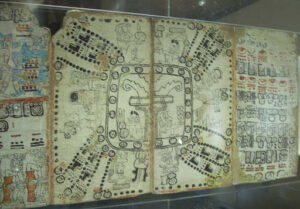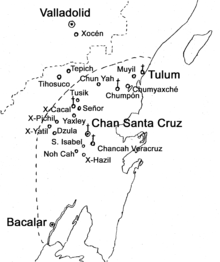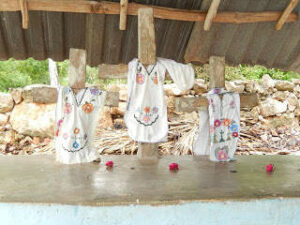CASTE WAR: PART 2

The Caste War of Yucatán began in 1847 and dragged on for decades. Tired from years of struggle, the Maya regained confidence from an unlikely source: a talking cross found deep in the jungle near a cenote. Revolutionary Jose Maria Barrera, driven from his Yucatán pueblo, led his band of people to an uninhabited forest and to a small cenote called Lom Ha (Cleft Spring). It was there he discovered a cross that was carved into a tree. The cross bore a resemblance to the Maya tree of life, la Ceiba, and a new religion formed around it, the cult of the speaking cross.
 JOSE MARIA BARRERA
JOSE MARIA BARRERA
Barrera said the cross transmitted a message which was later given as a sermon by Juan de la Cruz (of the Cross), a man trained to lead religious services in absence of a Maya holy man. Barrera also used a ventriloquist, Manuel Nahuat, as the mouthpiece of the cross, and through this directed the Maya in their war effort, urging them to take up arms against the Mexican government, assuring the people of the cross they would attain victory. All withstanding, the talking cross served as a symbol of hope for the Maya.
CRUZOB MAYA
From this speaking cross a community evolved—Chan Santa Cruz (Little Holy Cross)—and its inhabitants came to be called Cruzob, or followers of the cross. By chance, the cross bore three elements sacred to the Maya: the Ceiba tree, the cenote, and a cave. The cross was found growing on the roots of a Ceiba tree that sprung from a cave near a cenote. As explained by Nicoletta Maestra, the most sacred tree for ancient Maya is la Ceiba. According to their mythology, it is the symbol of the universe. Its roots are said to reach down into the underworld, the trunk represents the middle world where humans live, and its branches arch into the sky symbolizing the upper world and the thirteen levels of the Maya heavens. The Maya viewed caves as the entrance to the underworld and the domain of the rain gods.

TALKING CROSS
It wasn’t a far stretch for the Maya to believe the cross spoke to them. In the ancient Maya text, Chilam Balam, priests were said to have heard voices from the gods. So even this aspect of mysticism fell into acceptable practice for the Maya. To the Chan Santa Cruz, the voice of God came from that cross in that tree. It told the war chiefs that the battle should continue and the people should be patient in their fight.

To the Cruzob, even though the cross was inspired by a shamanic ventriloquist, the man speaking to them through the cross was God’s chattel, a mouthpiece of the gods. The Cruzobs believed this tree and this cross were connected underground, one hundred kilometers from Lom Ha cenote to Xocen—the center of the world—where the first speaking cross came from. As more and more people heard about the cross, a new religion was born.
Four crosses are said to exist at counter points—tips of the cross—marking the boundaries of the Cruzob Maya. The religion is still practiced and ceremonies performed in these four sacred shrine villages: Tixcacal Guardia, Chancah Veracruz, Chumpon and Tulum, whose geographic positions roughly describe the territory of the Cruzob Maya. In 1935, the Chan Santa Cruz from these last holdout villages signed a treaty of sorts which allowed the rest of Mexico to rule them. The jungle-wise Maya had kept the Mexican government at bay for nearly one hundred years.
COUNTER POINT IN TULUM
I visited the church of the speaking cross in Tulum years ago. Hiding in plain sight and sitting very near el Centro, it was a humble white-washed structure surrounded by trees. A narrow path with overgrown shrubs on either side disguised the entrance that led up to it. Before entering the churchyard, I passed through an enclosed area where a custodial guard sat. He gave a nod and I continued on towards the church. A posted sign instructed that shoes and hats were forbidden, as were photos.
Inside votive candles were lit and the musky scent of copal wafted through the darkened church. The interior was a large open room with seating. Straight ahead, three crosses covered in small white huipil-like veils sat on an otherwise barren altar. The room held little else except for a Maya woman kneeling on a blanket in a rear corner. Eventually I stepped back outside into blinding Yucatán sunshine.

ORIGINAL CROSS
 Of the four crosses held at the counter points, one is said to be the original. Tixcacal Guardia village elders fiercely guard what they swear is the original speaking cross and let no outsiders near it. It’s kept in a city within a city, much like the Vatican, according to blogger Logan Hawkes, safely hidden away from all save the Cruzob spiritual leaders—a head shaman and a circle of elders. For generations, Maya have flocked to these outposts to worship a wooden cross that became a dynamic part of their history during the Caste War of Yucatán. In Tixcacal Guardia, the church which houses the cross is open to the public on feast days only, but even then it’s said the artifact is not on display. It’s located on an altar covered with veils in a blocked-off section called La Gloria. No one is allowed to enter the inner sanctum and the cross is guarded day and night by Maya from the region.
Of the four crosses held at the counter points, one is said to be the original. Tixcacal Guardia village elders fiercely guard what they swear is the original speaking cross and let no outsiders near it. It’s kept in a city within a city, much like the Vatican, according to blogger Logan Hawkes, safely hidden away from all save the Cruzob spiritual leaders—a head shaman and a circle of elders. For generations, Maya have flocked to these outposts to worship a wooden cross that became a dynamic part of their history during the Caste War of Yucatán. In Tixcacal Guardia, the church which houses the cross is open to the public on feast days only, but even then it’s said the artifact is not on display. It’s located on an altar covered with veils in a blocked-off section called La Gloria. No one is allowed to enter the inner sanctum and the cross is guarded day and night by Maya from the region.
FELIPE CARRILLO PUERTO
Even though Chan Santa Cruz, the rebels’ capital city, now Felipe Carrillo Puerto in southern Quintana Roo, is not one of the counter points of the cross bearers, it was the main stronghold of the Cruzob Maya rebels during the war. To this day a rotating team of followers keep one week vigils at a local chapel where a flower-adorned shrine is set up in honor of the cross. Tihosuco, an hour to the northwest, is home to the Caste War Museum.
With history this unique, it’s not hard to realize that the newly founded Riviera Maya is but a shell for a more mysterious land of an ancient, respected people who have had an ongoing conversation with the gods and the universe for more than a millennium.


Leave a Reply